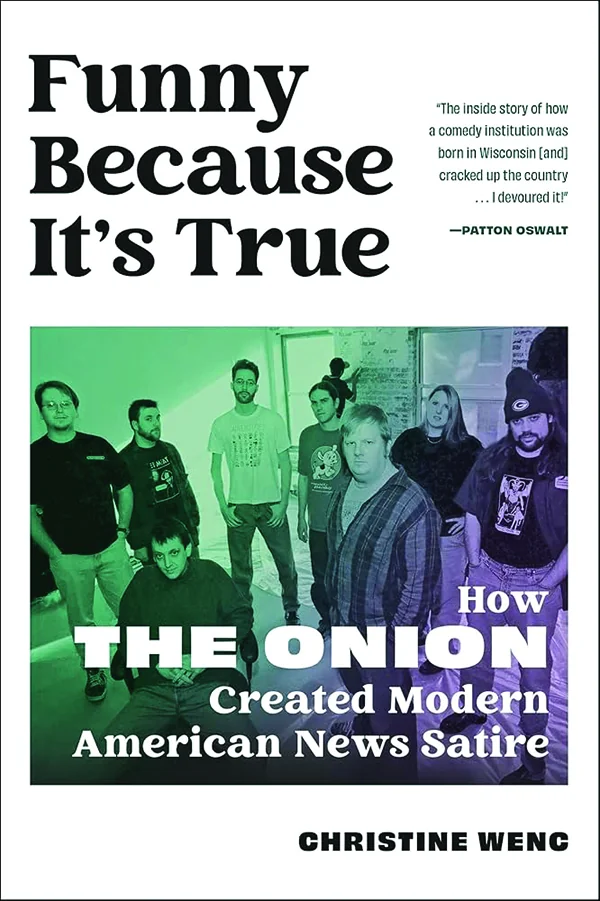When candidates for political office need a reboot, most campaigns turn to the consultant class. But during the 2024 presidential contest, former President Joe Biden ought to have excavated the archives of the Onion.
Last year, Biden’s image as a slumberous, easily dumbfounded senior citizen could only have been helped by the Onion‘s legendary fictitious stories asserting that he attended his vice presidential inauguration with his hair in a ponytail, that he washed his Trans Am in the White House driveway, and that he was no longer welcome at Dave & Buster’s. This version of Biden might have stood a chance against President Donald Trump.
To be clear, none of these things actually happened. However, during Biden’s reign as vice president, all of them were described in what was once America’s chief outlet for news satire as though they had happened. To be sure, the Onion has never stopped concocting made-up stories about Biden, but in recent years, they have felt increasingly sluggish and strained. In its glory days, the Onion specialized in insane-sounding stories and headlines that acquired a certain believability when issued in the straight-faced patois of the legacy media. Other vintage Biden-centric Onion dispatches, such as “Biden Investigated for Questionable Workers’ Comp Claim” or “Biden Has Guy Named Worm Sit In For Him at Cabinet Meeting,” were funny not only because they accurately captured something inherently lame and goofy in Biden’s persona, but also because they were presented in a manner indistinguishable from real stories in, say, the Associated Press. This was, in effect, the brand.

Running Press; 320 pp., $30.00
“That bland, rigid AP generic juxtaposition between the outrageousness of what we’re ‘reporting’ and the staid, bland formality of how we’re saying it, that’s a lot of what makes it funny,” Robert Siegel, a former editor of the Onion, said in a new book about the publication’s origins, ascent, and decline.
In Funny Because It’s True: How The Onion Created Modern American News Satire, author Christine Wenc, a member of the earliest incarnation of the staff, describes the pleasure of publishing fake news so authentic-sounding that it bamboozles its own readers. With a measure of pride, Wenc describes an early Onion article titled “Portrait Cries Real Tears,” which asserted that a photograph of a deceased, evidently spinsterish University of Wisconsin-Madison professor started producing real teardrops. “You guys,” a college student said upon reading the story, as overheard by an incredulous Wenc, “we have to go over there and check it out.”
Established in Madison in 1988, the Onion can trace its mandate to early contributor Matt Cook, who, in a meeting with co-founders Tim Keck and Christopher Johnson, enunciated the central premise: “I said, ‘How about we just make it all up? Have all made up stories, but play it like it’s a real newspaper?’” Working in Wenc’s favor is her seemingly encyclopedic command of the Onion‘s archives, including what Keck considers to be “the first real Onion article”: a story from February 1989 that bore the headline “DEAD GUY FOUND.” “You put it in the structure of a newspaper article, make little things big, big things little,” Keck said. “It’s a satire of a feeling of what newspapers are, rather than a specific political thing.” The story’s lede has not lost its capacity to tickle the funny bone: “A dead guy was found buried head first up to his waist in a snowbank this Monday morning, apparently the result of an accident with a snowplow” — the mystifying anonymity of the victim, and unknowing casualness of referring to him as a “guy,” being intrinsic to its humor.
Wenc describes the “standard varieties” of Onion jokes, including what writer Dan Vebber called “misplaced focus”: “Nation’s Popsicle Makers Concerned as Earth Hurtles Toward the Sun.” Another favorite was “celebration of boring”: “PEN STOLEN FROM DORM STUDY AREA.”
Although Wenc’s direct involvement in the Onion ceased in the early 1990s, she capably recounts various waves of writers, editors, owners, and would-be owners as the publication gathered force as a moneymaker and cultural influence. In 1994, she reports, its revenue reached between $300,000 and $400,000, and the following year, it settled on a specific newspaper format to mimic: the all-color, undeniably fun-to-read USA Today. In the first redesigned issue, from August 1995, the skybox teased a lifestyle story (“Carpeting: It’s in the House!”) and a weather map suggested that great swaths of the United States were under siege by locust swarms. Among the more pleasing aspects of the book are the numerous reproductions of Onion front pages, though, in time, it would be even more widely consumed on the internet. “We just felt like we went supernova,” Siegel said. “We had access to the whole world.” The staff grew from six to 60 over the course of the 1990s, Wenc reports.
This was a period of what might be called peak Onion, the era that begat the story “Clinton to Deploy Vowels to Bosnia,” advice columns on the order of “Ask a Coffin Salesman,” and, rather touchingly, the 9/11 issue, written by a staff that had, by then, reestablished its base of operations in New York. In the aftermath of the terrorist attacks, the issue’s headlines included “U.S. Vows To Defeat Whoever It Is We’re At War With” and “Hijackers Surprised To Find Selves In Hell.” “The Onion expressed grief and outrage about the attacks while also providing a deeper historical context within the jokes,” Wenc writes.
Whether recounting the triumph of the Onion‘s book, Our Dumb Century, or the debacle of its movie, The Onion Movie, Wenc’s affection for her subject is never in doubt. To the contrary, her book is full of often-tedious inside baseball. It is difficult to imagine even the most devoted Onion groupie being gripped by lines such as the following: “The Onion also still had its softball team, which was made up of not only current staff — both editorial and business — but also alums.” Her tone is too often solemn rather than mirthful. She loses the thread while documenting the publication’s business challenges, which, in the end, can be chalked up to the same rapidly changing media environment that has affected every publication from Vanity Fair to the Christian Science Monitor.
THE MALAISE-FREE CARTER ERA IN AMERICAN JOURNALISM
It is more difficult to explain why the Onion‘s ability to induce laughter has waned — why its Biden jokes of the late 2000s and early 2010s still land more forcefully than its Biden and Trump jokes of the present era. One should not readily dismiss ex-Onion editor Carol Kolb’s contention that, in the publication’s peak era, “we weren’t saturated with twenty-two thousand different types of unreal stuff coming at us.” But perhaps the real problem is not that the Onion has too many targets but too few: the sort of legacy media outlets whose identities it teasingly assumed have all gone on life support over the last decade or so. What good is it to parody the AP when the news service has been kicked to the curb of the White House? Has the average youngish Onion reader, if such people exist, picked up a real newspaper, like, ever? Where would they even find one?
Above all, though, the Onion‘s historically (but, until recently, not cripplingly) liberal bent no longer makes it an ideal vessel for anarchic comedy. Wenc concedes the appeal of a right-wing competitor, the Babylon Bee, which, she admits grudgingly, “I laughed at a couple of times a few years ago.” She notes the rise of Gutfeld! on Fox News. To truly let loose in the present environment, its writers and editors would have to set their sights on their own sacred cows. The Onion had its moment, but like the recent former president it once skewered so amusingly, it has long since passed.
Peter Tonguette is a contributing writer to the Washington Examiner magazine.























